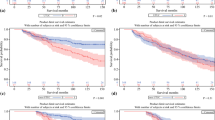Abstract
Objective
To identify the impact of preoperative pyuria on the bladder cancer recurrence and survival of patients who were treated surgically for UTUC.
Patients and methods
Study included 319 consecutive patients who were treated with RNU for UTUC. Cox proportional hazard regression models were used to evaluate the association of preoperative pyuria with outcome.
Results
Eighty patients (25.1%) had pyuria. Preoperative pyuria was associated with sex (P = 0.01), tumor focality (P = 0.01), tumor size (P = 0.05), tumor stage (P = 0.01), lymph node metastasis (P = 0.01), lymphovascular invasion (P = 0.02), and chemotherapy (P = 0.04). A total of 102 patients recurred, with a median time to bladder recurrence of 24.2 months. Bladder cancer recurrence-free survival rates for these 319 patients at 1, 3, 5, 7, and 10 years were 84.6, 72.4, 69.0, 68.3, and 68.0%, respectively. Preoperative pyuria was not independently associated with bladder cancer recurrence (HR 1.15; p = 0.5). Preoperative pyuria was associated with OS (HR 1.57; p = 0.02) and CSS (HR 1.65; p = 0.02). However, preoperative pyuria was not independently associated with OS and CSS (HR 1.07; p = 0.79).
Conclusions
Preoperative pyuria is unable to predict outcomes in a single-centre series of consecutive patients who were treated with RNU.



Similar content being viewed by others
References
Park S, Hong B, Kim CS, Ahn H (2004) The impact of tumor location on prognosis of transitional cell carcinoma of upper urinary tract. J Urol 171:621–625
Milojevic B, Djokic M, Sipetic-Grujicic S, Milenkovic-Petronic D, Vuksanovic A, Dragicevic D et al (2011) Bladder cancer after managing upper urinary tract transitional cell carcinoma: risk factors and survival. Int Urol Nephrol 43(3):729–735
Yamashita S, Ito A, Mitsuzuka K, Tochigi T, Namima T, Soma F et al (2016) Clinical implications of intravesical recurrence after radical nephroureterectomy for upper urinary tract urothelial carcinoma. Int J Urol 23(5):378–384
Hooker JB, Mold JW, Kumar S (2014) Sterile pyuria in patients admitted to the hospital with infections outside of the urinary tract. J Am Board Fam Med 27:97–103
Jablonska J, Leschner S, Westphal K, Lienenklaus S, Weiss S (2010) Neutrophils responsive to endogenous IFN-beta regulate tumor angiogenesis and growth in a mouse tumor model. J Clin Invest 120:1151–1164
Azuma T, Nagase Y, Oshi M (2013) Pyuria predicts poor prognosis in patients with non-muscle-invasive bladder cancer. Clin Genitourin Cancer 11:331–336
Yoshida T, Kinoshita H, Shimada S, Sugi M, Matsuda T (2017) Preoperative pyuria is a poor prognostic factor in patients with urothelial carcinoma of the upper urinary tract after surgery. Clin Genitourin Cancer 15(4):e543–e550
Satake N, Ohno Y, Nakashima J, Ohori M, Tachibana M (2015) Prognostic value of preoperative pyuria in patients with non-muscle-invasive bladder cancer. Int J Urol 22(7):645–649
Liang C, Wang J, Liu H, Huang L, Xu D, Qian S et al (2016) Preoperative pyuria predicts advanced pathologic tumor stage and worse survival in patients with urothelial carcinoma of the upper urinary tract treated by radical nephroureterectomy. Urol Oncol 34(9):418.e1–418.e7
Fleming ID, Cooper JS, Henson DE (1997) Genitourinary site. In: Touhey R (ed) AJCC cancer staging manual, 5th edn. Lippincott-Raven, Philadelphia, pp 231–246
Epstein JI, Amin MB, Reuter VR, Mostofi FK (1998) The World Health Organization/International Society of Urological pathology consensus classification of urothelial (transitional cell) neoplasms of the urinary bladder. Bladder Consensus Conference Committee. Am J Surg Pathol 22:1435–1448
Milojevic B, Dzamic Z, Kajmakovic B, Durutovic O, Bumbasirevic U, Sipetic Grujicic S (2015) Prognostic impact of preoperative anemia on urothelial and extraurothelial recurrence in patients with upper tract urothelial carcinoma. Clin Genitourin Cancer. 13(5):485–491
Milojevic B, Dzamic Z, Kajmakovic B, Milenkovic Petronic D, Sipetic Grujicic S (2015) Urothelial carcinoma: recurrence and risk factors. J BUON 20(2):391–398
Habuchi T, Takahashi R, Yamada H, Kakehi Y, Sugiyama T, Yoshida O (1993) Metachronous multifocal development of urothelial cancers by intraluminal seeding. Lancet 342:1087–1088
Harris AL, Neal DE (1992) Bladder cancer-field versus clonal origin. N Engl J Med 326:759–761
Mantovani A, Allavena P, Sica A, Balkwill F (2008) Cancer-related inflammation. Nature 454(7203):436–444
Wise GJ, Schlegel PN (2015) Sterile pyuria. N Engl J Med 372:1048–1054
Green DA, Rink M, Xylinas E, Matin SF, Stenzl A, Roupret M et al (2013) Urothelial carcinoma of the bladder and the upper tract: disparate twins. J Urol 189:1214–1221
Roupret M, Colin P (2013) Urothelial carcinomas of the upper urinary tract are now recognised as a true and distinct entity from bladder cancer and belong fully to the broad spectrum of onco-urologic neoplasms. World J Urol 31:1–3
Acknowledgements
This work was supported by the Ministry for Science and Technology of the Republic of Serbia, through Contact No. 175042.
Author information
Authors and Affiliations
Corresponding author
Ethics declarations
Conflict of interest
The authors declare that they have no conflict of interest.
Ethical approval
All procedures performed in studies involving human participants were in accordance with the ethical standards of the institutional and/or national research committee and with the 1964 Helsinki declaration and its later amendments or comparable ethical standards.
Informed consent
Informed consent was obtained from all individual participants included in the study.
Additional information
Publisher's Note
Springer Nature remains neutral with regard to jurisdictional claims in published maps and institutional affiliations.
Rights and permissions
About this article
Cite this article
Milojevic, B., Dzamic, Z., Bojanic, N. et al. Urothelial carcinoma of the upper urinary tract: preoperative pyuria is not correlated with bladder cancer recurrence and survival. Int Urol Nephrol 51, 831–838 (2019). https://doi.org/10.1007/s11255-019-02133-1
Received:
Accepted:
Published:
Issue Date:
DOI: https://doi.org/10.1007/s11255-019-02133-1




